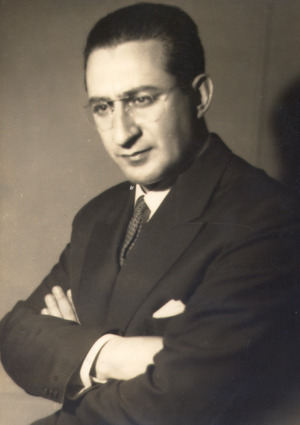Camargo Guarnieri facts for kids
Mozart Camargo Guarnieri (born February 1, 1907 – died January 13, 1993) was a famous Brazilian composer. He was born in a town called Tietê, São Paulo, in Brazil.
Guarnieri learned to play the piano, write music (composition), and lead orchestras (conducting). He studied these skills in São Paulo, Brazil, and later in Paris, France. His music became very popular in the United States in the 1940s. This gave him chances to conduct his music in big American cities.
He was a very important person in Brazilian music. Guarnieri worked as a conductor for orchestras. He was also a member of the Academia Brasileira de Música (Brazilian Academy of Music). He even became the Director of the São Paulo Conservatório, a music school. He wrote many different kinds of music. This included big orchestral pieces called symphonies and concertos. He also wrote operas, chamber music, piano pieces, and songs. Many people think he was the most important Brazilian composer after Heitor Villa-Lobos. He received a special award called the Gabriela Mistral Prize shortly before he passed away.
Contents
His Name Story
Guarnieri was born in Tietê, São Paulo. His birth name was Mozart Guarnieri. But when he started his music career, he thought "Mozart" sounded too grand. So, he decided to use his mother's family name, Camargo, as a middle name. From then on, he signed his name as M. Camargo Guarnieri. In 1948, he officially changed his name to Mozart Camargo Guarnieri. But he still often used just the first letter of his first name.
His father, Michele Guarneri, was from Italy and loved classical music. He named Camargo's brothers after famous composers. One brother was named Rossine (after Gioachino Rossini). His other brothers were named Verdi and Bellini.
His Musical Life
Guarnieri studied piano and composition at the Conservatório Dramático e Musical de São Paulo. In 1938, he received a special scholarship. This allowed him to travel to Paris. There, he continued to study composition and conducting.
His music won important awards in the United States in the 1940s. This gave him the chance to lead orchestras playing his music. He conducted in big cities like New York, Boston, Los Angeles, and Chicago. He was a leading figure in Brazilian music. He held many important roles. He was a conductor for the São Paulo Orchestra. He was also a member of the Brazilian Academy of Music. He directed the São Paulo Conservatório. There, he taught students how to compose and conduct.
In 1936, he was the first conductor of the Coral Paulistano choir. He wrote a lot of music. This included symphonies, concertos, and two operas. He also wrote chamber music, many piano pieces, and over fifty songs. In 1962, the Soviet Union invited him to a meeting of composers in Moscow. Just before he died in 1993, he received the Gabriela Mistral Prize. This award recognized him as the greatest living composer in the Americas.
What Music He Wrote
Camargo Guarnieri wrote many different types of music. Here are some of his most important works:
Operas
- Pedro Malazarte (a funny opera, first shown in 1952)
- Um homem só (a sad opera, first shown in 1962)
Music for Orchestra
- Symphonies: He wrote six symphonies. These are large pieces for a full orchestra.
- Symphony No. 1 (1944)
- Symphony No. 2 "Uirapuru" (1945)
- Symphony No. 3 (1952)
- Symphony No. 4 "Brasília" (1963)
- Symphony No. 5 (1977)
- Symphony No. 6 (1981)
- Overtures: These are pieces often played at the beginning of a concert or opera.
- Abertura Concertante (1942)
- Abertura Festiva (1971)
- Suites: These are collections of short musical pieces.
- Suite infantil (Children's Suite) (1929)
- Tres Dansas para Orquestra (Three Dances for Orchestra) (1941). The first dance, "Dansa Brasileira," is very famous.
- Suite IV Centenario (1954)
- Suite Vila Rica (1957)
Concertos (Music for Solo Instrument and Orchestra)
- Piano Concertos: He wrote six concertos for piano and orchestra.
- Piano Concerto No. 1 (1931)
- Piano Concerto No. 2 (1946)
- Chôro for piano and orchestra (1956)
- Piano Concerto No. 3 (1964)
- Seresta for Piano and Orchestra (1965)
- Piano Concerto No. 4 (1968)
- Piano Concerto No. 5 (1970)
- Piano Concerto No. 6 (1987)
- Violin Concertos: He wrote two concertos for violin and orchestra.
- Violin Concerto No. 1 (1940). This piece won a big contest in 1943.
- Chôro for violin and orchestra (1951)
- Violin Concerto No. 2 (1952)
- Other Instrument Concertos: He also wrote "Chôro" pieces for viola, cello, flute, clarinet, and bassoon with orchestra.
Chamber Music (Music for Small Groups of Instruments)
- String Quartets: He wrote three pieces for four string instruments.
- String Quartet No. 1 (1932)
- String Quartet No. 2 (1944)
- String Quartet No. 3 (1962)
- Cello Sonatas: He wrote three sonatas for cello and piano.
- Violin Sonatas: He wrote seven sonatas for violin and piano.
- Viola Sonata (1950)
- Sonatina for Flute and Piano (1947)
Piano Music
Guarnieri wrote many pieces just for the piano.
- Dança Brasileira (Brazilian Dance) (1928)
- Dança Selvagem (Wild Dance) (1931)
- Ponteios (five books, written between 1931 and 1959)
- Dança Negra (Black Dance) (1946)
- Estudo (Studies): He wrote 20 studies for piano, which are pieces to help musicians practice.
- Suite Mirim (1953)
- Sonatina (three sonatinas for piano)
- Piano Sonata (1972)
Vocal Music (Songs)
- Cinco Poemas de Alice (Five Poems by Alice) (1954) for a female singer (soprano) and piano.
See also
 In Spanish: Mozart Camargo Guarnieri para niños
In Spanish: Mozart Camargo Guarnieri para niños
- List of Brazilian musicians


